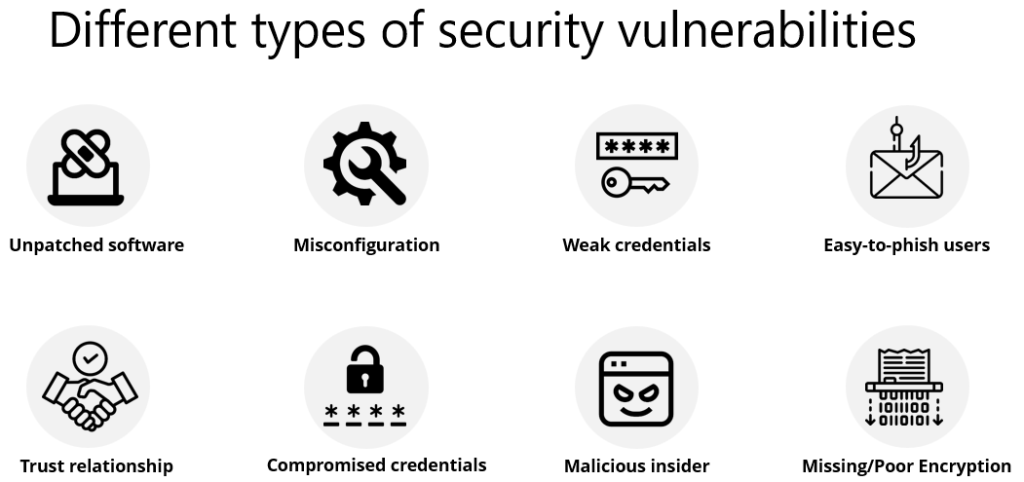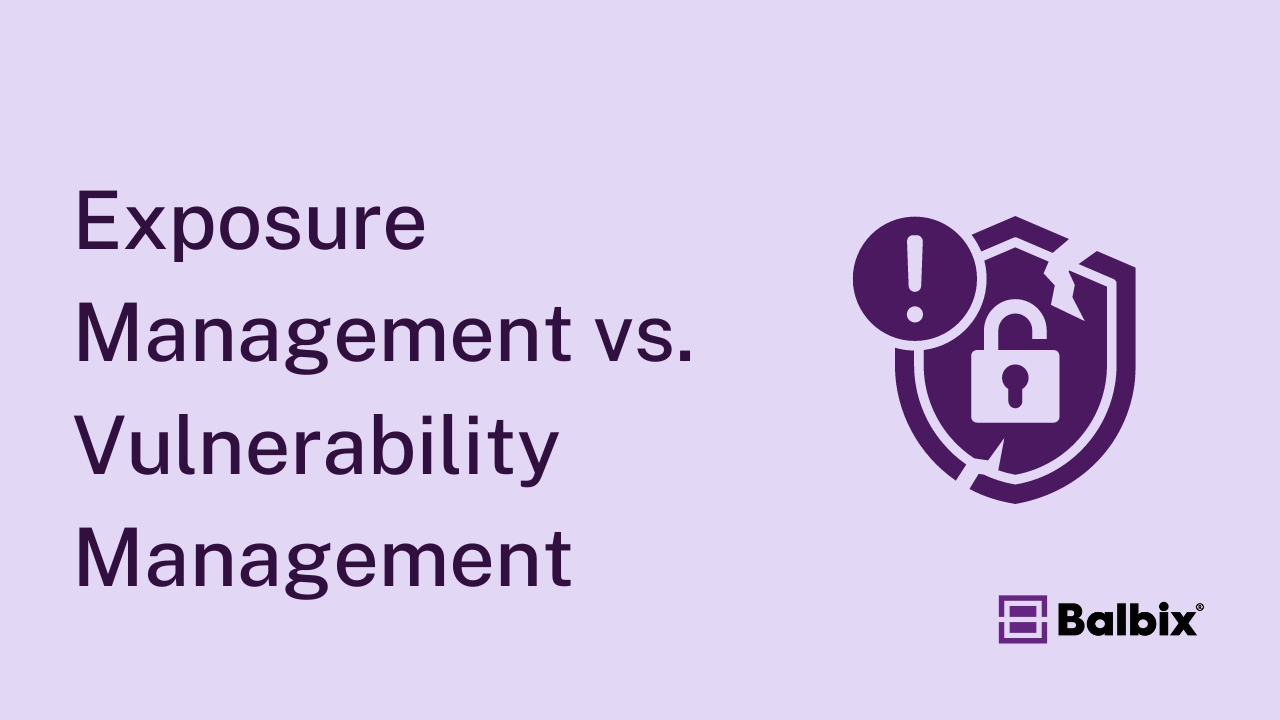A vulnerability in cybersecurity is a flaw or weakness in a system that cybercriminals exploit to gain unauthorized access or cause harm. These vulnerabilities often stem from coding errors or misconfigurations and can be leveraged to disrupt operations, steal data, or compromise security. Once identified, vulnerabilities are registered as CVEs (Common Vulnerabilities and Exposures) and assessed for their potential risk.
Types of Security Vulnerabilities
Security vulnerabilities come in various forms, each posing unique risks attackers can exploit. Understanding these vulnerabilities is crucial for maintaining a secure environment. Let’s discuss several different types of vulnerabilities.

- Unpatched Software: Failing to update software leaves known bugs attackers can exploit to execute malicious code.
- Misconfigurations: Default settings or unnecessary services can open doors for unauthorized access.
- Weak Credentials: Easily guessed passwords provide an easy entry point for attackers.
- Phishing-Prone Users: Users tricked by phishing attacks may inadvertently expose systems to risks.
- Trust Relationship Exploits: Attackers exploit trusted connections between systems to spread breaches.
- Compromised Credentials: Stolen credentials enable unauthorized access to sensitive systems.
- Malicious Insiders: Employees or vendors intentionally misuse their access to compromise data.
- Poor Encryption: Weak or absent encryption allows attackers to intercept and steal sensitive information.
Other Vulnerability Examples
- Application Vulnerabilities: Flaws in software due to coding errors, lack of validation, or outdated components.
- Zero-Day Vulnerabilities: Unknown security flaws are exploited by attackers before the vendor can issue a fix.
- Ransomware: Attackers exploit various vulnerabilities to deploy ransomware, encrypting data and demanding payment for decryption keys.
- Application Vulnerabilities: Flaws in software due to coding errors, lack of validation, or outdated components.
- Cloud Vulnerabilities: Security gaps in cloud environments due to misconfigurations or insecure APIs.
- IoT Vulnerabilities: Flaws in connected devices that attackers can exploit to access networks.
- Supply Chain Vulnerabilities: Security gaps in the supply chain where attackers insert malicious components.
Read more about the specific types of vulnerabilities.
Understanding Software Vulnerabilities
Software vulnerabilities are flaws in a system that attackers can exploit to access unauthorized data, disrupt services, or extract sensitive information. These vulnerabilities often stem from coding errors, insufficient validation, or outdated components.
Common vulnerabilities include buffer overflows, which run arbitrary code due to excess input; injection flaws like SQL injections; and poor error handling that exposes sensitive details. Mitigating these vulnerabilities requires consistent code reviews, timely updates, and thorough testing to keep systems secure and resilient.
What’s the Difference Between Vulnerabilities, Exploits, and Risk?
A vulnerability is a flaw in an asset’s design, implementation, operation, or management that a threat could exploit. An exploit is the method used to exploit a vulnerability; a risk is the potential for loss when that threat occurs.
What is a cybersecurity vulnerability?
A cybersecurity vulnerability is a weakness that can be exploited to gain unauthorized access or perform unauthorized actions on a computer system.
Vulnerabilities allow attackers to access a system, run code, install malware, and access internal systems to steal, destroy, or modify sensitive data. If undetected, attackers can pose as superusers or system administrators with full access privileges.
Stop Sabotaging Your Cybersecurity
Avoid the 11 common vulnerability management pitfalls

What is a cybersecurity risk?
Risk refers to the potential damage that could occur if a vulnerability is exploited. It combines both the likelihood and impact of the threat. Cyber risk is the expected loss from a cyberattack or data breach. Vulnerability is part of the likelihood in the risk equation.

What is a Cybersecurity Exploit?
An exploit is a method or technique cybercriminals use to exploit a security vulnerability in software or hardware. It allows attackers to gain unauthorized access, disrupt services, or steal data. Exploits are often used in cyberattacks to breach systems and cause harm.
What Causes Cybersecurity Vulnerabilities?
Vulnerabilities are often caused by outdated software with known security issues, commonly tracked as CVEs (Common Vulnerabilities and Exposures). However, they can also come from weak passwords, misconfigurations, and insufficient or missing encryption. These issues expose systems to attacks and security breaches.
A deep dive into some of the most common vulnerabilities can be found here.
When Should Known Vulnerabilities be Publicly Disclosed?
Following responsible disclosure practices, known vulnerabilities should be publicly disclosed after a 90-day window. This allows researchers to report the flaw to the affected company, giving them time to develop and release a fix before the vulnerability is announced.
Public disclosure after this period is crucial for alerting users and preventing exploitation by bad actors. Bug bounties and internal audits are vital strategies for identifying and addressing these vulnerabilities to enhance security.
What is Vulnerability Management?
Vulnerability management (VM) is a continuous process of identifying, assessing, prioritizing, and fixing security vulnerabilities across an organization’s IT assets and software. By addressing these weaknesses, VM helps reduce the attack surface, lower the risk of cyber threats, and protect critical systems and data. The process typically involves scanning for vulnerabilities, evaluating their impact, and implementing fixes or mitigations promptly.
Effective vulnerability management is essential for maintaining a proactive security posture, ensuring regulatory compliance, and safeguarding the organization from evolving cyber threats.
Frequently Asked Questions
- What is the difference between a threat and a vulnerability?
-
A threat is a potential danger that could exploit a vulnerability to cause harm, such as cyberattacks. A vulnerability is a weakness in a system that a threat, such as outdated software or poor security practices, can exploit.
- Is phishing a threat or vulnerability?
-
Phishing is a threat. It is a malicious tactic used by attackers to deceive individuals into revealing sensitive information or installing malware. It exploits existing vulnerabilities in human behavior and security practices.
- Is malware a threat or vulnerability?
-
Malware is a threat. It is malicious software designed to damage or gain unauthorized access to systems. It exploits vulnerabilities to achieve its goals, such as stealing data or disrupting operations.
- What is the difference between a bug and a vulnerability?
-
A bug is an unintended error or flaw in software that causes it to function incorrectly. A vulnerability is a specific type of bug that poses a security risk, allowing attackers to exploit it to compromise the system’s integrity or confidentiality.


